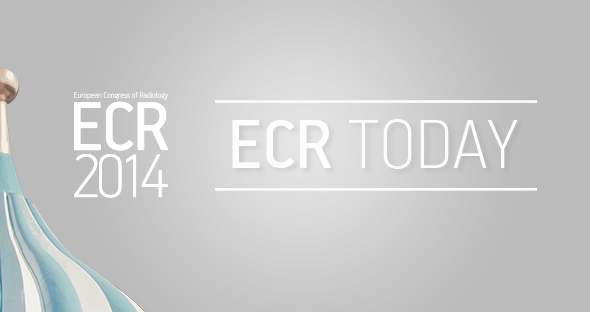Experts explain how to avoid pitfalls in FDG PET/CT imaging
Watch this session on ECR Live: Thursday, March 6, 16:00–17:30, Room I/K
Tweet #ECR2014IK #SF3
The demand for PET/CT studies is increasing and so is the need for radiologists to improve their knowledge of this important modality. One of the many areas that require their attention is the occurrence of pitfalls related to the uptake of Fludeoxyglucose (18F), commonly called FDG, the most commonly used tracer in PET/CT imaging. A dedicated Special Focus session at the ECR will offer attendees useful clues on how to avoid these pitfalls and correctly interpret images.

Katrine Åhlström Riklund is director of the medical school and deputy head of the department of radiation sciences at Umeå University, Sweden. She is 2nd vice-chairperson of the ESR’s Congress Committee.
FDG uptake by tissue is also a marker for glucose uptake, which is closely correlated with certain types of tissue metabolism. This means that FDG can show not only disease-related changes but also normal, healthy metabolic changes in the body. “Not everything that shines is pathological. To know the difference, you have to train and learn what is really a disease and what is the physiological distribution of this tracer,” said Professor Katrine Åhlström Riklund, a radiologist specialised in nuclear medicine at Umeå, Sweden, who will moderate the session.
To help radiologists, speakers will share advice regarding FDG uptake in oncology, neurology and cardiology.
Most FDG PET/CT studies are currently being carried out to help stage cancer, and plan and follow-up therapy. The combination of FDG and PET/CT imaging is particularly useful in several different malignancies. Because a tumour cell divides rapidly and has a high rate of metabolism, FDG uptake usually corresponds to disease. Once physicians know the extent of the disease, they can make a more accurate diagnosis and treatment plan, especially in targeted therapies.
But since FDG uptake is a non-specific process, it results in both physiological and pathological tissue uptake. Inflammatory cells, which typically show an increased level of metabolism, could be misinterpreted as cancerous cells, a very common pitfall in cases of inflammatory lymph node. “But if you are interested in diagnosing inflammatory or infectious disease, FDG is of great help because it accumulates in inflammatory changes,” Åhlström Riklund said.
However, some tumours may show a high degree of inflammatory changes which are only located in the tumours; so inflammation in oncologic diseases may also help to make the correct diagnosis.
Radiologists should also pay attention to uptake in scarred and radiation-treated regions, since these can show increased metabolism. Last but not least, the distribution of FDG in some organs, for instance the bowels, can prove challenging because of the uneven degree of uptake in this organ.
FDG PET/CT is also useful in cardiology and neurology but pitfalls are present in cardiology, where the combination enables the evaluation of the myocardium’s function, and in neurology, where the alliance helps assess brain function in diseases like dementia, Parkinson’s and epilepsy.
Shortcomings may also occur in inflammation, for instance in the evaluation of patients with prolonged fever of unknown origin, infections after joint-replacement surgery, graft infections after endovascular surgery, vasculitis in autoimmune disorders, or patients with granulomatous diseases.
The key to properly understanding and interpreting PET/CT imaging is knowing the mechanism and pathways of FDG in different tissue types. “You need both competence and confidence. The first requirement is to have a lot of knowledge to interpret the examination correctly, and the second requirement is to have good knowledge of the form of the disease you are going to evaluate. Double reading is also a way to make sure that you are doing good interpretations,” Åhlström Riklund said.
Correct preparation of the patient before the examination may also help to reduce pitfalls. “FDG is taken up in metabolic activities, so if you, for instance, talk a lot after your FDG injection, you will have false-positive uptakes in the vocal chords. Likewise, if you do a lot of exercise, you will have a lot of uptake in the muscles,” she said.
The session is aimed at specialists but other radiologists should attend the session to improve their knowledge of PET imaging, she insisted. “The PET part in imaging is increasing, and it is now necessary to gain more knowledge of both PET and bio imaging, because patients will increasingly undergo PET/CT examinations. The same is true for PET/MR when this modality becomes available. As radiologists, we have a lot of knowledge of MR, but we also need to know more about PET studies and the disease itself to make a good interpretation. PET/CT imaging is the future, so everybody should come to the session.”
Special Focus Session
Thursday, March 6, 16:00–17:30, Room I/K
SF 3: Pitfalls in FDG PET/CT imaging
» Chairman’s introduction
K. Åhlström Riklund; Umea/SE
» Oncology
T.F. Hany; Zurich/CH
» Cardiology
J. Knuuti; Turku/FI
» Neurology
K. Van Laere; Leuven/BE
» Inflammation
J. Sorensen; Uppsala/SE
» Panel discussion:
Is bright always bad?


